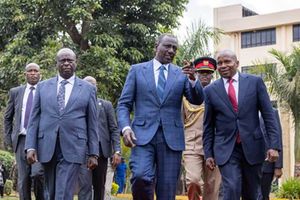Finding solutions in drought: How women in Kenya are restoring their lands

Samburu women harvesting grass seeds along the buffer zones in Westgate Community Conservancy in Samburu East.
What you need to know:
- Although women contribute 60-80 per cent of food production in Kenya, they are often excluded from discussions on land use and climate adaptation strategies.
- This exclusion, according to gender experts, is not just an issue of fairness but a significant obstacle to creating lasting change.
Naisiae Lomonyak, a 37-year-old mother of five, faces an impossible choice in the parched landscape of Kimana, Kajiado County. Like many women in Kenya’s drylands, she is caught between the urgent need to feed her family and the long-term damage caused by deforestation and land degradation.
“The drought was a terrible time,” Naisiae recalls of the 2020-2022 drought, her voice heavy with sadness. “We lost so many animals. There was nothing to eat.”
The 2020-2022 drought, the worst in 40 years, left devastation in its wake, claiming livestock and crops across Kenya’s arid regions. Desperate for survival, Naisiae turned to charcoal burning, a practice many in the region rely on for income.
By cutting down acacia trees on her land, she earned just enough to provide for her family. Encouraged by the earnings, she even bought more trees from the village to continue the work. But while charcoal burning provides short-term relief, it has far-reaching consequences.
Deforestation and overgrazing are worsening land degradation, contributing to the unpredictable weather patterns that now plague the region. “I know it’s not good for the environment,” Naisiae admits, wiping sweat from her brow. “But what else can I do? My family depends on me. My husband is a bodaboda rider, and he doesn’t bring in much.”
Naisiae’s dilemma is shared by countless women across Kenya’s drylands, where climate change is intensifying, and survival is becoming harder by the day. Women, often responsible for securing food and water for their households, bear the brunt of these challenges.
As droughts grow longer and more severe, crops fail and livestock die, leaving women like Naisiae with few options. They walk long distances to fetch water and food, while their children face malnutrition. Their earnings are barely enough to buy essentials.
Experts argue that addressing these challenges requires integrating gender into environmental management projects, especially in Kenya’s drylands.
“By empowering women and ensuring their participation in decision-making processes, we can create more sustainable and equitable solutions,” says Boru Mamo, Director General of the National Environment Management Authority (NEMA), at a recent meeting on gender disparities in dryland management. Over 80 per cent of Kenya's land area is classified as arid and semi-arid, covering 29 counties and is home to about 16 million people.
Although women contribute 60-80 per cent of food production in Kenya, they are often excluded from discussions on land use and climate adaptation strategies. This exclusion, according to gender experts, is not just an issue of fairness but a significant obstacle to creating lasting change.
Karen Elizabeth, Gender Policy Officer at the United Nations Convention to Combat Desertification (UNCCD), emphasizes that involving women from the start of sustainability projects is crucial.
“Women are central to livelihoods at the village level,” she explains. “Yet, they are often left out of decision-making. This isn’t just a justice issue; it’s a human rights issue. When women’s needs aren’t factored in, these projects become less effective.”
In response, organisations like the Global Environment Facility (GEF) are focusing on women-led solutions for drought resilience. GEF’s Dryland Sustainable Landscapes Impact Programme (DSL-IP), active in 11 countries including Kenya, promotes land restoration and sustainable farming with a special emphasis on gender equity.
“The contribution of women is often overlooked in projects like these,” says Verona Collantes, Senior Gender Specialist at GEF. “But women are the backbone of rural economies. In the fishing industry, for example, women do the most labour-intensive work—cleaning, sorting, drying, and smoking fish—yet their contributions are rarely acknowledged.”
In Kenya, NEMA is implementing a four-year initiative in Kajiado and Narok counties to strengthen land management, combat deforestation, and restore degraded areas. These regions were among the hardest hit during recent droughts, where soil erosion and land degradation severely impacted livelihoods.
“We’re trying to change mindsets,” says Leonard Tampushi, National Project Coordinator of the Sustainable Forest Management program at NEMA. “For years, people have kept large herds of cattle, but during drought, these herds die off. We’re helping communities see the value of sustainable land use and smaller, healthier herds.”
One promising solution is the creation of grass banks, where communities collect and store grass seeds to rehabilitate grazing lands. Pastoralists contribute seeds to the bank, which are then distributed for planting, helping restore vegetation and improve soil health.
“We’re training farmers—especially women—on how to plant and harvest these grass seeds,” Tampushi explains. “Once mature, the grass can be dried and packaged into bales, providing fodder for livestock during dry seasons.”
Despite these initiatives, challenges remain. While there are many policies in place to address climate adaptation, the implementation often falls short, says Collantes. “There’s a disconnect between global programs and what’s happening on the ground. We need stronger links to ensure that these initiatives reach the communities that need them most.”
Kenya aims to restore 10 million hectares of land by 2030, but experts agree that to achieve this, more support is needed at the village level. Tampushi stresses the importance of having extension officers on the ground to guide farmers in sustainable practices.
“There is a lot to be done,” he says. “But we’re starting to see progress. Communities are beginning to understand the importance of land restoration.”
For women like Naisiae Lomonyak, these initiatives offer a glimpse of hope. “We need to find ways to live in harmony with the land,” she says, gazing out at the dry fields around her. “We can’t keep cutting trees forever. We have to think of the future.”




